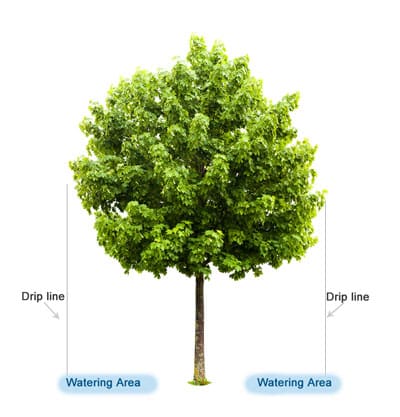There’s no denying summers can be really hot in central NJ and eastern PA. While you probably know that the heat can be tough on you, did you know that it can have negative effects on your trees as well?
During the summer, trees sometimes suffer from heat stress. In this article, we go over what exactly it is, how you can spot it, and how you can keep your trees healthy and stress-free throughout the worst of the summer heat.
“But,” you may be asking yourself, “don’t trees get enough water from all of the summer storms?” Thunderstorms tend to drop a lot of rain quickly, which means that most of the rainwater runs off into storm sewers and ditches, and not much of it is absorbed into the ground. Trees need to be watered deeply; the roots are usually several inches below the ground so water needs to get down to them to have any effect. So while a long, slow, constant rain might adequately water trees at the roots, don’t depend on summer storms alone to keep your trees hydrated and healthy.
Signs of Heat Stress in Trees
As you know, trees lose their leaves in the autumn, after the weather changes and the foliage turns all shades of colors. But you may notice some trees dropping leaves in the hot weather, especially birch and hickory trees. This is one of the signs of heat stress in trees. Other signs can include:
- leaves that wilt or turn yellow,
- rust colored spots or bumps on leaves,
- sap oozing from the trunk,
- leaves that look “scorched” on the edges, or
- a failure to produce healthy new growth.
Trees suffering from heat stress are losing water faster than they can replace it. Under normal circumstances, trees get most of their water supply through their roots from the water in the surrounding soil. This water eventually evaporates into the air from the underside of the tree leaves through a process called evapotranspiration. During especially warm or dry periods, the water is transpired more quickly, and trees become dehydrated.
What to do About Heat Stress in Trees

Water trees around the perimeter of the canopy – this is where most of the roots are
Just as it’s important for humans and animals to stay hydrated, it’s also important for trees.
The first sign of heat stress is usually wilted leaves, so if your trees are showing signs of distress, be sure that they’re receiving enough water. If the leaves don’t perk up when the weather cools and sun sets in the evening, then the tree definitely needs more water!
Trees need to be watered deeply but infrequently, so a drip irrigation system is the best option. As long as you water deeply enough (make sure the water gets down to the roots), you shouldn’t have to water more than once a week.
You could also use a soaker hose or a garden hose with slowly trickling water (just be sure to move the garden hose to a few different locations).
While you may think that your trees are being watered if you use a sprinkler for your yard, sprinklers lose a lot of water to evaporation, and the water tends to land on the leaves rather than on the ground. And as we’ve already learned, trees need water to reach their roots underground.
Don’t water too close to the trunk, as that could cause rot (and besides, that’s not where the roots are – they’re out farther from the trunk). Instead, water in a wide circle around the tree. The tip of the branches is called the edge of the canopy (or the drip line), and watering just below the edge of the canopy is ideal.
Trees that have been planted within the last two to three years need more water than older trees, as the roots are still growing into the ground. That takes energy, which requires – you guessed it – more water (water helps carry the nutrients trees need so they can be absorbed by the roots)! So pay special attention to younger trees during the hot summer months.
Additionally, if you notice any damaged or dead branches on a tree, remove them (prune out only the dead parts) so that the tree can focus on staying healthy. If you plan to do this yourself, be sure you don’t make any of these common pruning mistakes.
Be Vigilant About Heat Stress
Signs of heat stress look very similar to signs of disease and pest problems, especially scorched leaves. If you’re not sure which is it, first be sure your trees are getting enough water. Then consult a Certified Arborist for his or her professional opinion.
A careful inspection by a tree care professional can determine what treatment is needed to bring your tree back to full health. If a tree is really stressed, we can do a deep root watering and apply a special blend of organic fertilizers that will perk it up and provide the moisture it needs to get through the rest of the summer.
GET THE LATEST NEWS
Subscribe to the Organic Plant Care Newsletter and get timely and helpful tips and updates monthly.
There's no spam - we promise!





